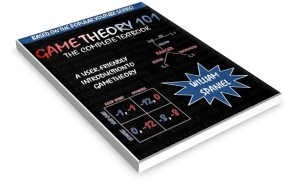In a one-shot prisoner’s dilemma, both players can’t help but defect. We have also seen that the same logic is true of any finite length prisoner’s dilemma. Does this extend to an infinitely repeated game?
This lecture finally shows that cooperation can work as long as the players are sufficiently patient. One strategy that can get cooperation to work is called grim trigger. Its premise is simple. A grim trigger player begins by cooperating. Then, in each subsequent period, the player continues cooperating as long as all players have cooperated in every period prior. But a single defection from either player “triggers” the player to defect in all future periods. It is therefore “grim” because it offers no forgiveness. But this is also a good starting point: precisely because it is so vicious, if it cannot inspire the players to cooperate, no other strategy will.
Takeaway Points
- Checking whether grim trigger is an equilibrium requires two steps. First, we must verify that within the “punishment” subgame it is an equilibrium for both players to defect. Second, we must verify that in each cooperative period no player wants to deviate to defecting.
- The first part of this is easy. Mutual defection in every period is a subgame perfect equilibrium by virtue of the fact that mutual defection is an equilibrium of the stage game.
- The one-shot deviation principle makes the second part tractable. Rather than think through an infinite number of deviations, we can just check whether in any generic period that a player earns more by defecting for that period and earning the temptation payoff, flipping the grim trigger in the process, and earning the mutual defection payoff for the rest of time.
- Players prefer mutual cooperation as long as they place sufficient value on the future. Thus, both players choosing grim trigger strategies is a subgame perfect equilibrium as long as δ is sufficiently large.

